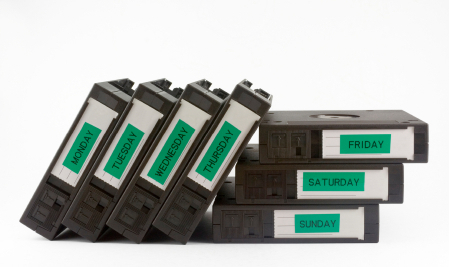Is Your Backup really Backing you Up?
 Most Businesses currently use some form of backup and have an understanding of the two purposes it performs. These purposes are to enable the business to restore either an individual file or restoring an entire file system. In either circumstance the restoration that is performed is valuable.
Most Businesses currently use some form of backup and have an understanding of the two purposes it performs. These purposes are to enable the business to restore either an individual file or restoring an entire file system. In either circumstance the restoration that is performed is valuable.
When a backup is done it’s only a still shot of the data gathered at a specific moment in time. Different data needs different captures as some data changes more frequently than other data. In order to properly cover the frequency the data is changed there are three primary types of backup processes; Full, Incremental and Differential backups.
- Full, is exactly what it says it is. It’s necessary for crucial system(s) in the event of a catastrophic failure from either hardware failure or natural disaster.
- Incremental backup looks at the properties of a file and evaluates if the files modified time is more recent than the current back up of that file.
- Differential backups perform the same search in the properties of a file like the Incremental backup does, however, the difference between the two is that the Differential will continue to update a file once it’s been modified until the next Full backup has been performed.
The different types of backups work best in conjunction with one another, as this will allow the amount of data needing to be stored and the type of media used to store it on, to be used effectively.
How the data is stored, to say the least, a huge variable as the media used depends heavily on the amount of data stored, how often it’s backed up, the types of backups performed and the value you place on your data and potential down/recovery time.
- Floppy Disks are just about obsolete and have very limited uses. Harware drivers are on of the few uses left for this removable media.
- Tapes have the longest use history for the purpose of backing up data. Tapes have reasonable storage capacity and an initially low media cost however tapes are subject to wear, are sequential in nature and have a lot of room for human and programming error. Two of the most common errors are:
- wrong tape was put in and didn’t back up that night
- the tape didn’t eject which could increase the cost of the backup over time depending on service contracts or support for this media
- CDs and DVDs are another good, portable solution with the potential of being able to restore individual computers. Unfortunately, this media doesn’t have the solid history tapes have and their capacity is considerably less than tapes. Similar to tapes, CDs and DVDs leave the door open for human error.
- Flash Drives have great portability and are potentially the easiest to use out of the medias mentioned thus far. They do have a relatively high cost for capacity and are subject to human error.
- Hard Disks are great for higher capacity needs and ease of use. They can be challenging in portability. Internal hard drives aren’t typically removable from the machine and external hard drives are awkward and can be damaged very easily. This solution also has the potential for being a costly one.
- Remote Backup protects against worst case scenarios such as natural disasters and has a lot of flexibility in capacity and function. Once it’s setup, the program keeps the people that need to be aware of the backup status up to date and automates everything – allowing for less human error. Depending on resources available and the amount of data needing to be sent there can be a temporary concern for transmit speed. This solution has many cost variations depending on the service provider.
The type of media used is very critical and we’ve only explored on side of the issue for backups – backing up the data. There’s still a whole other side of this equation in the restoration process. How quick and labor intensive is this process? Have you even attempted to perform a backup to verify the method works? Backups can very easily become a 30 page dissertation on all of the possibilities and scenarios – still not covering everything that needs to be covered for specific situations.
There are many questions relating to having an effective backup policy. Some of the key questions to keep in mind are: Do you have a backup policy? How often is this policy reviewed? Has this process ever been tested for effectiveness to get you up and running again? There typically isn’t a single solution and we encourage you to look into your backup policy to make sure you’re covered. Send us an email if you have a specific area related to backups that you would like us to cover in greater detail in a future issue – topics@databitsnews.com
[whohit]2009Backup[/whohit]



4 Comments
Most reliable Web site Submit I’ve Ever before Spotted 🙂
I’ve really enjoyed reading and reviewing the points in your well-written content. Thank you for presenting this useful information in an interesting and understandable format.
I am continually looking online for articles that can help me. Thx!
I’m more than happy to find this web site. I need to to thank you for your time just for this wonderful read!! I definitely liked every bit of it and I have you saved as a favorite to see new things in your site.